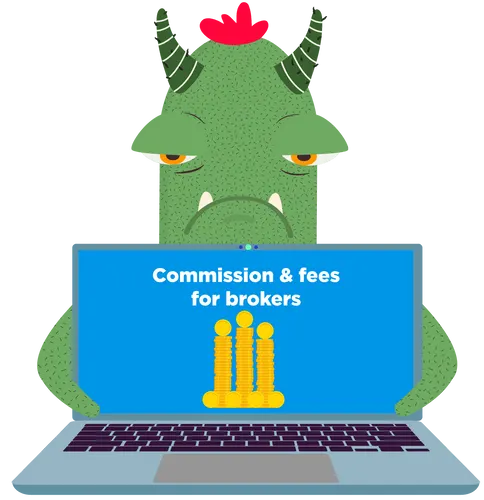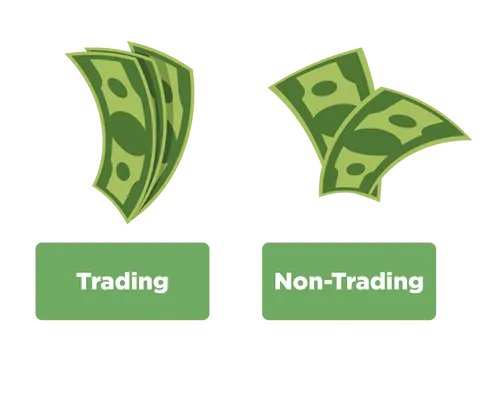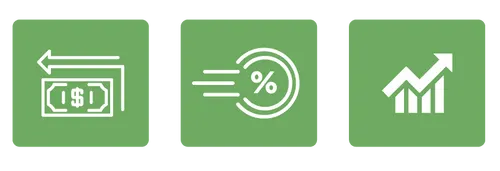Our partner, XM, lets you access a free demo account to apply your knowledge.
No hidden costs, no tricks.

In trading, you are definitely going to deal with a broker. There are different ways for the broker to make money, and it is crucial for you to understand which broker fees you are going to face, so you can accurately calculate your gains and losses.
Broker fees are mainly dependent on the services you are going to receive from the broker. Basically there are two types of fees, one relates to trading activities and the other to non-trading activities.
You will come across different names for these charges, but the main difference between brokerage fees and commissions is that the fee is usually a fixed charge, while the commission is a percentage that changes depending on the volume a trader is using.

There are two types of brokerage companies that you might encounter. The first is what is called a full-service broker which acts more as a portfolio manager, and an investment manager, looking after the growth of the client’s capital.
The second is called a discount broker and they only provide the platform for investors to execute financial market orders, and to perform financial trading activities.
In this guide, we are going to focus on the discount broker, and what sort of brokerage fees you can expect from them.

As we have mentioned, there are two kinds of fees. These are:
As a trader, you are looking for a broker that charges fewer fees, so you don’t end up paying a big chunk of your profits to them just for the use of their platform. Usually, brokers state their fees on their webpage before you open your trading account. However, we will help you to understand them better so that you can have a clear idea of how much capital you would need before getting started in Forex or stocks trading.

As the name suggests, this type of fee is charged when you deposit money to trade, enter/leave any financial market, and perform any other activity that supports your trading.
The way brokerage fees are calculated depends on whether the fee is fixed or variable, the fixed is just a certain amount that is charged per transaction, and the variable is a percentage of the transaction amount.
Whether for the first time, or any normal deposit, some brokers charge fees on the deposit transactions. However, more and more brokers are starting not to charge any fees on deposits, in an attempt to attract more investors.
These can be fixed charges. For example, if you are depositing $1,000 and the broker charges a flat $5 fee, it will reflect on your account as a $995 deposit.
On the other hand, if the stockbroker charges a commission percentage, say for instance 1% of the deposited amount, then that same $1,000 deposit will reflect in your account as $990, minus the $10 (or 1%) commission fee.
These are charges that a broker takes when you open a trading position in the market.
For example, if you are planning to buy 100 shares of Amazon stock, and each costs $100, and the broker’s commission is 0.1% of the volume; then the stockbrokers' commission on this trade will be $10, which is 0.1% of the $10,000 that you are going to invest to buy the stocks
This is one of the most important terms in the world of trading, it is one of the main criteria a trader uses when deciding on the right broker.
To put this simply, the spread is the difference between the buying and the selling price. Here the brokerage will not charge a separate fee, but rather incorporate it in the sell/buy prices on offer.
When you look at any product in the financial markets, you will see two prices. The price at which you can buy an asset (Ask), and the price at which you can sell an asset (Bid).
Usually, brokers set the buying price higher than the selling price, these prices fluctuate depending on movements in the stock price. Traders aim to sell their trading position at a higher price than the price at which they purchase it.
Let’s say for example you want to buy Amazon stocks, you will see two prices on the trading platform, Amazon stock “buy” price = $101; Amazon stock "sell" price = $100. So if you buy 1 share and then sell it again, you will incur a loss of $1, which is the stock brokerages' commission.
The same applies to any other product in the different financial markets, while different products have different spread ranges, the range can be narrower or wider.
Common products or currency pairs usually have tighter spread ranges, while less-traded products or exotic currency pairs have a wider spread range.
The spread is denoted in terms of pips, whereas a pip is the smallest change in the price of a product or a currency exchange rate, and 1 pip usually = 0.0001.
As a trader, you are looking to minimize the stockbroker commissions that you need to pay, by finding a broker that offers the tightest spread ranges over different markets, or over a specific product that you are looking to trade.
A margin is an amount that a broker lends to the trader in order to be eligible to open a larger market position than their capital allows for. Let’s say you deposited an amount of $2,000, and you want to trade some stocks, but the trade position you want to open will require an investment of $5,000.
The remaining amount of $3,000 can be supplied by the broker as a loan, and this loan is called leverage. The stockbroker fees here are based on an interest rate that you have to pay to the broker when the position is closed.
The interest rate varies between brokers and can be different from one asset to another, but it is usually between 1% and 5% of the total amount that you borrowed from the broker.
These are commissions charged by the broker to keep your trading position open until the next day. They take the form of an interest rate that is paid by the investor as a separate charge.
Brokers have different rules when they set the calculations of the swap rates, and it is different between different products or currency pairs.
Usually, these swap rates are not charged directly to your trading account and are billed separately, so they do not affect the capital being used in the current trading position.
The broker converts currencies itself if you are using a different currency than the one required for the trading position or for a deposit.
Let’s say that you are buying US corporate stocks, but you are depositing money using your Euro bank account, the broker will exchange the Euros that you have deposited into USD before buying the amount of stock you require.
Likewise, if the brokerage trading account is denoted in USD and you have deposited money in your account using Euro, the broker will convert the amount from Euro to USD.
The difference between the buying and selling price is usually what the stockbroker charges, which is similar to exchanging currencies at any exchange booth, however, the rates here are decided by the broker.
In addition to the exchange rate spread, a broker may charge an additional fee or add a service fee to this transaction.
Such conversion can highly damage your trading capital, and it would be a good idea to exchange money yourself before depositing. Moreover, you can open a bank account in the same currency required by the broker to reduce extensive conversion rates.

The broker charges these fees to manage your account and keep it running. These fees also concern any activities that do not affect your trading positions.
If you happen to leave your account inactive for a long period of time, you will be charged inactivity fees.
Usually, if you do not execute any trading activity for one month at least, your account will be subject to hefty brokerage fees, which take the form of monthly charges.
These charges differ from broker to broker. They can be as much as $20 to $50 a month, and some brokers increase the inactivity charge the longer your account remains inactive.
This kind of fee is charged by the broker when you cash out funds from your trading account to your personal bank account. It can be in the form of a flat or a commission rate from the amount being withdrawn.
The commission on withdrawals is usually changing according to the method you are using for the withdrawal, and the average brokerage fee percentage is in the range of 1% to 3% of the volume being withdrawn.
It is important to note that some withdrawal methods are subject to charges even if the broker says that they take 0% commission on withdrawals. That is because the method of withdrawal includes intermediary banks or financial institutions that take their part of the commission percentage.
For example, if you are withdrawing your funds using a bank wire transfer, you might get charged by the bank handling this transfer, and your bank can charge their own rate, which can be anywhere from $5 to$50 depending on the banks' regulations.
This fee is usually taken once a year, and it entails the service fees for the broker to handle your trading activities and deposits around the year.
Some traders might not know that brokers charge fees for maintenance, as not all brokers charge them. This sort of fee is slowly fading away or being incorporated into other trading-related charges.
However, brokers who do charge it usually take between 0.5% and1.5% of the total assets a trader is holding in their trading account, or it can be a flat fee like $100 per year. Maintenance fees can vary greatly and are all dependent on the broker. So make sure to read through all the fine print before choosing a broker so you can be sure that you will be paying them as little as possible and keeping as much of your profits in your pocket.

In fact, it is impossible to avoid broker’s fees, because this is a service that you are paying for. However, knowing what percentage stockbrokers charge and what fees can be avoided, will help you manage your account with the lowest amount of fees and commissions possible.
There are a handful of brokers who take zero commissions on some trading activities, such as deposits, and withdrawals. This can primeraly be found with relatively small brokers that are trying to attract as many customers as possible.
However, you need to make sure that such a broker is licensed and regulated. Some scam brokers use this technique to lure traders in order to con them out of their money; a practice which affects the reputation of the legit ones as well.
An ECN broker is a broker that uses Electronic Communications Networks to give direct access to other participants in financial markets. This system works on matching different traders in different markets, which is a better deal for brokers since there is no dealing desk that can trade against the clients.
The ECN brokers’ commission fees are fewer in number and lower because these brokers combine the different price quotations from different market participants, which offers clients the tightest spread ranges.
The fees applied by a broker can be either a fixed rate or a percentage of the volume being traded, deposited, or withdrawn. Considering the choice between these types of fees is crucial if you want to avoid being overcharged.
Let’s say that you want to deposit an amount of $5,000, you want to choose between broker A which has a fixed fee of $10 and broker B which charges a commission rate of 1%
With broker A, you are going to be charged only the $10 fee, so with this example, the net amount deposited is $4,990. However, broker B will charge 1% of the amount deposited, which is $50 (0.01 * 5000).
In the above example, it is easy to say that Broker A is suitable given the amount of money being used because it charges less commission on deposits. On the other hand, if you are using a smaller amount of money, a broker that offers a percentage commission rate would be a better choice.
Thus, you need to know how to calculate the brokerage fee from the amount that is being used, which will help you decide on what type of commission structure is more suitable for you.
If you decide to stay away from trading, and you return after a few months, you will be surprised by the number of charges your account has faced during the inactivity period. Over time these charges will accumulate, and you might run out of money in your trading account and risk the account being frozen.
Therefore, if you are stepping away from trading, it is better to pause your account if your broker allows you to do so. If not, you may even be better off closing it and reopening your account whenever you decide to resume trading. It will be more affordable than being charged inactivity fees.
Leverage is a double-edged sword, it can enable a trader to open market positions of a higher value and amplify the gains, or amplify losses if the trade goes in an unfavorable direction.
Brokers usually offer leverage that can go up to 1:500, and such huge leverage is risky because it multiplies the trading capital by 500 times and if the trade goes into a loss, the trader will be indebted to the broker and will be held liable for the amount that was borrowed and lost.
Therefore, try to use leverage moderately, in a way that can elevate the trading position of a trader, and won't impose aggravated losses to your capital if things go south.
For beginner traders, using leverage of between 1:10 and 1:20 is considered fair, it enables the trader to multiply the trading capital, and at the same time, if the market moves in a losing direction, the trader will not become extremely indebted to the broker.
Our partner, XM, lets you access a free demo account to apply your knowledge.
No hidden costs, no tricks.
A broker’s fee is the income a broker receives for trading services. Since brokers do not get paid monthly fixed amounts for their services, they get paid in the form of commissions for the different services they provide.
Commission fees on deposits and withdrawals are common, as well as the fees charged by brokers when a trader opens a position in any financial market, known as the spread.
The flat fees are charged as a fixed rate without any changes, so if a broker’s fee is $10 for trading, whenever you open a market position the broker will take a $10 fixed fee. However, if the fee is represented by a percentage, then the percentage will be taken from the amount being traded. Let’s say you are trading using a capital of $1,000 and the broker’s commission is 1%, the broker’s commission is (1000 * 0.01) = $10.
Deposit and withdrawal fees are one of the most common types of brokerage fees. They are usually charged as a percentage of the amount of money being deposited/withdrawn. Another common type of fee is the spread, which is the difference between the asking price and the bid price, and the broker charges it whenever a client opens a trading position.
The spread is the difference between the buying and selling price. When you look at any product in the financial markets, you will see two prices. These are the price at which you can buy an asset (ask) and the price at which you can sell an asset (bid). The spread range differs from one asset to another, and traders look for the tightest (smallest) spread range because it means fewer payments to the broker.